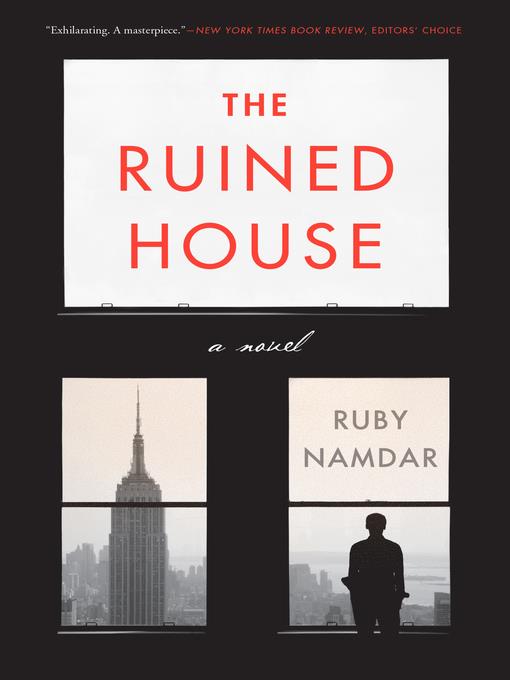
The Ruined House
A Novel
کتاب های مرتبط
- اطلاعات
- نقد و بررسی
- دیدگاه کاربران
نقد و بررسی

September 1, 2017
An elegant NYU professor at the peak of his powers and pleasures is reduced to a quivering puddle by a violent, unsought, yearlong spiritual awakening.For 52-year-old academic superstar Andrew Cohen, the term charisma is a "cheap inadequacy." "His dress and appearance, his speech and body language, his ideas and their expression--all had a refined aristocratic finish that splendidly gilded everything he touched." He has a 26-year-old girlfriend, Ann Lee, and a stunning apartment overlooking the river; he publishes in the New Yorker; he even has a good relationship with his ex-wife. Was a character ever more cruelly set up for a fall? Namdar's debut follows poor Andrew for a year beginning on the sixth day of the Hebrew month of Elul in 5760, or Sept. 6, 2000, when he has the first of many increasingly intense spiritual experiences which will ultimately destroy his sanity and his life. The myriad subsequent chapters are each identified by both a Hebrew and a regular date and grouped into seven "books." These books are separated by pages telling a second story set in ancient Israel and designed in the style of the Talmud, and this is just the tip of the iceberg vis-a-vis the self-importance of this apocalyptic, overwritten, bloated screed against assimilated American Judaism and self-satisfied elite academics. Between the fusillades of exclamatory prose, the innumerable dream sequences, hallucinations, and visions, the detailed and repetitive descriptions of vile pornography and disgusting physical phenomena, the tedious chunks of student papers and other quoted material, the clear hostility of the author toward the main character, the brutally slow pace and repetitive plot development, and the bizarre, ill-advised handling of 9/11, one begins to wonder if Namdar is intentionally punishing the reader. Is S&M a literary genre? Maybe in Israel, where this novel won the Sapir Prize, that country's equivalent of the Man Booker. Consider yourself warned.
COPYRIGHT(2017) Kirkus Reviews, ALL RIGHTS RESERVED.

September 1, 2017
Winner of the 2014 Sapir Prize, Israel's equivalent of the Man Booker Prize, this artfully translated work features Andrew Cohen, a 52-year-old professor of cultural studies at New York University. Urbane and sophisticated, the divorced Cohen lives a stylish, carefully curated existence on the Upper West Side of Manhattan at the turn of the millennium. Though he considers himself a rational, secular, intellectual Jew, with disdain for the garish religiosity of his ancestors, he begins experiencing strange visions involving the ancient Temple in Jerusalem. This existential crisis takes on nightmarish qualities, as his hallucinations as well as his daily encounters begin to offer incessant and tormenting glimpses of death and decay. As the dated chapters move toward what the readers know will be a contemporary slaughter, the tension and horror multiplies. VERDICT Though Cohen's relentless, inexorable decline can get a little repetitive, and the conclusion feels somewhat anticlimactic, this is an imaginative and visionary work about one man's spectacular mid-life crisis, framed by sacred texts and filled with poetic and portentous passages. Reminiscent of the work of Nicole Krauss.--Lauren Gilbert, Sachem P.L., Holbrook, NY
Copyright 2017 Library Journal, LLC Used with permission.

September 25, 2017
In Namdar’s disappointing debut, Andrew Cohen, an NYU professor and formerly prolific writer, has a long, slow, incredibly banal mid-life crisis. Stretched out over the year leading up to Sept. 11, 2001, Cohen wallows in self-pity, ambling toward a breakdown that reads more like a man grasping at his waning privilege than a human being fearful in the face of mortality. Although Cohen left his ex-wife and daughters decades ago, when the girls were little, only now does he realize how absent they are from his life. Vulnerable for perhaps the first time, he’s haunted by his abandonment of them and yet can’t seem to bring himself to take responsibility. Otherwise, Cohen goes on to suffer from dwindling sexual mojo, writer’s block, and nightmares. He feels suffocated by his beautiful, decades-younger girlfriend (a former student) and doesn’t understand why he isn’t awarded a promotion he’d been expecting. Perhaps because of the unrelenting internal narration, the book remains plotless. Cohen falls asleep, has anxiety attacks, stays awake, rushes into taxis, eats or forgets to eat, and finds himself bewildered by his own dysfunction. In prose as tedious as Cohen’s misery, Namdar tries to underscore the significance of his narrator’s collapse by cataloguing every hour of every day. But Cohen remains the jerk he’s always been, and the reader is left wishing he would see what they do—that his self-absorption only intensifies, rather than dissipates, against the forthcoming tragedy of actual human suffering looming on the horizon.

























دیدگاه کاربران